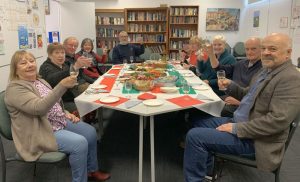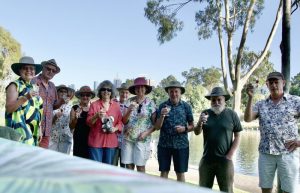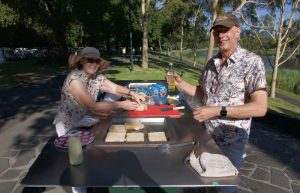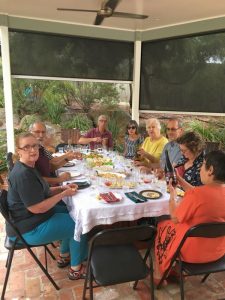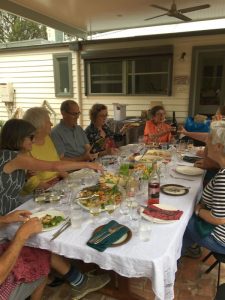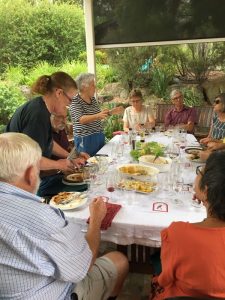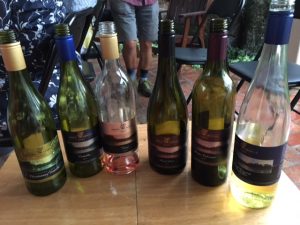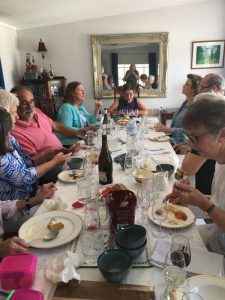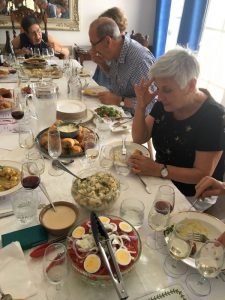As a complete novice and an enjoyer of the occasional glass of wine, I and 11 others signed on the Wine Appreciation Class of 2017. What a blast it was. The fun, the friendship, the food and (of course) the wine, all with the gentle guiding hand of Karen Coulston to make the class an enlightening and enjoyable event.
At this point, it is probably important to say that each of the four glasses in front of us were for tasting. This was not meant to be a grog fest, but a serious class.
Some of our members enjoying the class around the pre-set table:

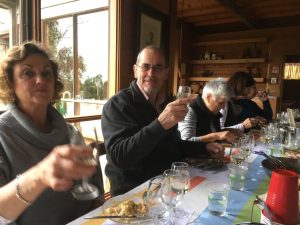

The class was based on the assumption that different wines are best paired with particular foods. Our job was to confirm or otherwise this assumption. Well, also to enjoy the experience, of course.
Karen, who is somewhat renowned in local winemaking, has degrees in Chemistry (BSc(hons) (Monash), MPhil (London)) and Wine Science (BAppSc (CSU)), started a boutique winery along with her since-departed husband, Laurie. With Laurie now enjoying the other side of wine-making heaven, Karen allowed us and others to be educated in the appreciation of wine. It also allowed us to enjoy her quite unique property in Yarrambat.
Apparently the first classes Karen ran, whilst successful, lacked an additional ingredient – and that turned out to be food: the perfect combination with any, if not all, wine.
Our class attendees, Deb T and Peter, Jude and Fidel, Pam, Robin, Simon, Greg, Ruby, Jenny, Liz, Vera and myself (Deb F), found ourselves at Karen’s mercy. Wines and food were pre-organised, in situ or via email.
We covered red wine, white wine, sparkling wine, and wine varieties within sub groups. We learnt of flavours and smells, what is grassy, what is musky, what is fruity, and what is downright horrid. But then there were the delights of some beautiful wines which surprised us because, whilst they may have been cheap, they improved with a particular food group. For instance, the cabernet with the duck, the sparkling with the oysters and vietnamese rolls, and the chocolate with the shiraz! All amazing and brilliant.
Many times, as we all got to know each other better, Karen needed to bring us back to attention by the tingling on a glass so that she could remind us of the attributes of a wine that we were tasting.
After learning that Karen had held a previous class to make their own wine, we insisted we had to as well. So, a rosé was chosen, and our group gathered grapes from anywhere that still had enough (we were late in the season for good grapes). We learned how to press the grapes and started the process to turn these little beauties into our magnificent wine. Karen has continued the process, adding as required until bottling day (still to come).
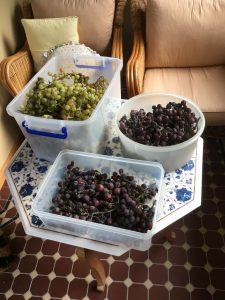
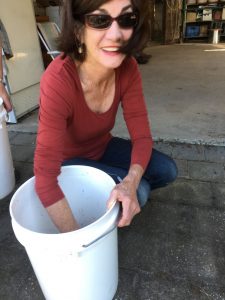
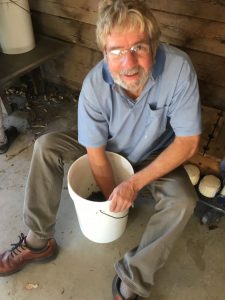
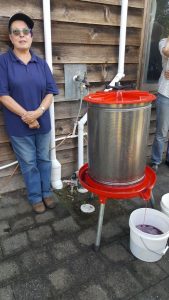
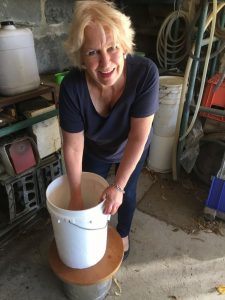


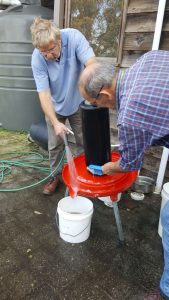
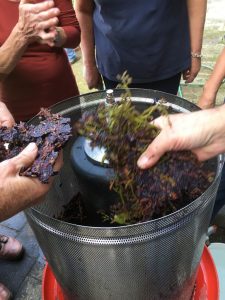
Each week added to the previous one and the experience was better every time. The inclusion of food with the wine appreciation was a master stroke and just made the occasions truly special. Each person contributed either a prescribed bottle of wine or pre-determined food.
We loved and laughed all the sessions long. Pam, so heavy into permaculture, was able to enlighten us on more sustainable food management production. Deb T sang us into a coffee shop with her magnificent two-octave voice at the end of a day tour. Fidel tolerated the white wines when we really knew that he exclusively preferred red. Jude was stunned when Fidel told the group she (Jude) would make carbonara – her face was priceless. Robin, so quietly spoken, would put in his bid for his contribution first in the auction only to be beaten by louder voices, week after week. Liz would look with amazing grace at others when they were over-jolly with a particular approving gaze in her eye. Vera regaled us with her excited eyes and Ruby gave us her comic look of entertainment when she picked up on conversation at the other end of the table. Greg’s car broke down on the way one time with a vital food ingredient of our meals and Simon refused to eat any oysters cooked or otherwise. And Jenny excited us by saying she would bring lobster to our sparkling wine day and got hailed down to yabbies, which turned into prawns. It was all so good no matter what. Peter nearly rolled over with laughter watching Deb F’s face when served with the vietnamese rolls that flopped in a most interesting manner.
Our class was introduced to particular varietals like Sauvignon Blanc, Pinot Noir, Riesling, Shiraz and Chardonnay. Then we looked at wine types and styles such as aromatic whites, Mediterranean reds and whites, new world reds, sparkling and (still to come) fortified wines. We had two all-day-long bus tours to introduce us to wineries of differing styles and the food that they paired with their wines. We saw sparkling wine being made and had tours to the vineyards cellars, including Dame Nellie Melba’s beautiful property, Coombe, in the Yarra Valley.
We are part of U3A for many reasons, learning, connection, community, many other personal reasons. This class with Karen embodies as close to all these elements as I and my fellow class mates have experienced. It was, and is, great, just great. As a group, we have decided to continue the friendship and meet regularly hereafter.
Thank you Karen. Most sincerely, thank you.

